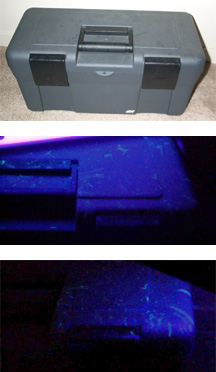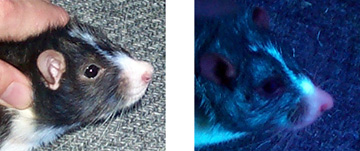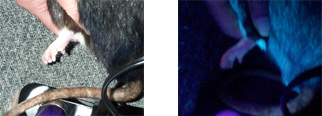Introduction
Rats dot their environment with tiny drops of urine, called urine marking, or scent marking. Urine marking is a form of chemical communication. Urine is full of information about the rat who produced it: its species, sex, age, reproductive status, sexual availability, social status, individual identity, and current stress level, as well as the age of the scent mark itself.
Urine marking serves several functions. It acts as a sexual attractant and advertisement to rats of the opposite sex. Urine marking may also serve as a habitat labeling system. Rats may urine mark their environment in order to maintain an optimum odor field, a sort of olfactory landscape, which may help them maintain a sense of familiarity with an area. Urine marking of the environment may be serve as an index of spatial knowledge.
We humans can barely perceive scent marks ourselves, because once a scent mark dries it becomes invisible to us. We may be able to detect some of them through touch, as a scent mark on a hard surface may attract a thin layer of dust and may feel rough to the touch, but this is a far cry from the rat's awareness of his scentscape.
Ultraviolet light
|
|
|
Fluorescent black light |
What other substances glow under a black light?
Urine, porphyrin, semen, sperm and saliva fluoresce under a blacklight.
Blood does not fluoresce under a blacklight: it looks black. To glow blood needs to be treated with a chemical developer such as Luminol, which makes the blood glow in the dark briefly even without a blacklight. This glowing effect lasts only a few seconds and is used to investigate crime scenes (Penven 2005). Skin does not fluoresce, but it looks purple under a black light.
With this knowledge in mind, I purchased a fluorescent black light
at my local hardware store. For those of you who want to try this
yourselves, make sure to get a fluorescent black light, the
kind with a fluorescence tube, and not an incandescent black
light, which is a regular light bulb with a special coating.
Incandescent bulbs aren't fluorescent and therefore don't work (I've
tried).
Scent marks
First, I turned the black light onto the rats' environment to see if I could detect urine marks (a pursuit known as peeseekery). I took one of the rats' metal shelves out of their cage and photographed it under normal and black light:
|
|
|
Photograph of a cage shelf under normal light (left) and ultraviolet light (right). The rats' urine marks, faintly visible under normal lighting conditions, glow under the black light. |
Then I took a look at the rats' nestbox. I give the rats a new cardboard nestbox every week, so the marks below were all made in less than seven days:
|
|
|
Photograph of the rats' nestbox under normal light (left) and ultraviolet light (right). The urine marks are visible under normal light as a faint mottling, but become more apparent under a fluorescent black light. |
As you can see from the marks on the nestbox, the rats prefer to sit on the front left quadrant of the box (the other areas are overhung with a shelf and ramp). From the photograph, it looks like the rats deposit scent marks in several ways. They deposit a scent mark as they step on the box, dragging their urogenital area over the box's edge, thus depositing a small drip on the front panel and a smear along the top. The smear points in the direction they were moving at the time. Next, the rats deposit rounder, less smeared scent marks on the top of the box itself. Lastly, the rats scent mark the "sill" or "threshold" of the doorways as they go in and out.
Lastly, here are photographs of a plastic tool chest that the rats climbed on:
|
|
|
Photographs of a plastic tool chest under normal light (top), and of its front right corner under black light (middle and bottom). Under ultraviolet light the scent marks glow. |
Rats under a black light
Next, I looked at the rats themselves. I was startled to see that all three rats had pink muzzles! This effect was most visible on Cricket, who has the most white fur on his muzzle. The nose, lips, chin, and whisker bed were colored pink:
|
|
|
Cricket's nose looks pure white under a normal light (left). Under a fluorescent black light (right) his muzzle glows pink. |
As I examined the rats further I found that other body parts looked pink or purple, too, particularly areas with thin, delicate skin. The rats' ears looked purple or violet:
|
|
|
Snip's ears are a normal tan color under normal light (left), but under a fluorescent black light (right) they look violet. |
The eyes and the skin around them looked dark purple:
|
|
|
Cricket's ears and eyelids, normally a pale tan (left), look purple under a black light (right). A little mucus around his nostrils looks clear and colorless under normal light, but fluoresces dark pink under ultraviolet light, probably from porphyrin. |
The tops of the rats' paws looked pink under the black light, and the soles of their feet looked purple (my own skin was purple too).
|
|
|
Cricket's hind foot under normal light (left) and under a fluorescent black light (right). The sole is dark purple and the top of the paw is pink under ultraviolet light. |
Black light photography
Equipment: I made the pictures on this page with a first generation point-and-shoot digital camera (Kodak DC240), a fluorescent black light from the hardware store, and some tinkering with Adobe Photoshop. I am not a professional photographer by any means, so I unfortunately do not have any high-tech filters, lenses, or black lights. Such equipment would doubtless produce much better photographs!
Constraints: My camera does not do well in low light conditions, and the black light doesn't put out much visible light. This had three important consequences: (1) I could only take close-up photographs. Any pictures taken far away turned out completely black. (2) Even with the close-ups, many of the photos turned out very dark with glaring whites. These required tweaking to make them presentable. (3) My camera had trouble focusing under low light, making many of the black light photos blurry, so I shrank the images and kept them small to increase their sharpness.
More black lights would help address these constraints, but at $17 per light I didn't want to buy more than one.
Photo tweaking: Using the advice of a photographer friend, I used the following procedure in Adobe Photoshop to brighten the dark areas of the photographs and tone down the whites. This procedure is more subtle than tinkering with the overall brightness and contrast of the image:
- Copy the picture into a new file
- Desaturate the color (e.g. turn it into a black and white image)
- Invert it so that light is dark and dark is light
- Return to the original document and make a new layer
- Paste desaturated, inverted image into the new layer
- Change layer mode to "Overlay"
- Fiddle with the opacity of the inverted layer if necessary
- This procedure can be repeated on the same picture to enhance the effect
Ultraviolet light and safety: The ultraviolet light spectrum is artibrarily divided into three ranges that have different health risks: UVA (low risk), UVB (medium risk) and UVC (high risk). Black lights emit UVA. Brief exposure to UVA isn't a big problem, but prolonged UVA exposure can irritate or damage the eyes and skin. So, if you try this yourself, don't stare right into the light and don't expose your rats to the light for long.


